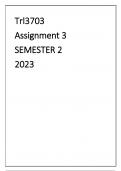Trl3703
Assignment 3
SEMESTER 2
2023
, 1. Examine the enactment of the Air Services Licensing Act within the framework of air
transportation. Address the subsequent elements within your response: (15)
• Define deregulation.
• Highlight the distinctions between an unregulated market and the formerly regulated
market.
Enactment of the Air Services Licensing Act within the Framework of Air Transportation
The enactment of the Air Services Licensing Act holds considerable significance in the context
of air transportation, particularly within the framework of regulatory control and industry
structure. This Act represents a pivotal moment that transitioned the airline industry from a
heavily regulated market to a more liberalized and competitive environment.
The Air Services Licensing Act played a central role in regulating the entry, operation, and exit
of airlines within the industry. In a regulated market before its enactment, government
authorities wielded substantial control over various aspects of airline operations, including
route allocation and pricing. This created a scenario where government agencies acted as
gatekeepers, determining which airlines could operate, where they could fly, and how much
they could charge.
Upon the enactment of the Air Services Licensing Act, governments relinquished much of
their control, leading to a paradigm shift toward a more open and competitive market. The
Act facilitated the liberalization of the airline industry by removing many of the entry and exit
barriers that had previously existed. Airlines were granted the autonomy to decide their
routes, fares, and operational strategies based on market demand and competition, as
highlighted by Vasigh (2013).
This transformation from a regulated to an unregulated market structure had profound
implications. The Act ushered in a new era of competition, where airlines were incentivized
to differentiate themselves through innovative services, competitive pricing, and enhanced
customer experiences. Consumers benefited from increased choices, as airlines strived to
offer attractive options to win their patronage.
The enactment of the Air Services Licensing Act paved the way for increased efficiency in the
industry. As noted by Williams (2012), regulated industries often exhibited inefficiencies due
to escalating costs and high fares. With deregulation, airlines were empowered to respond
dynamically to market conditions, leading to optimized pricing and greater cost-effectiveness.
This, in turn, fuelled higher load factors and greater overall travel demand, creating a positive
cycle of growth and efficiency.
A notable historical example is the deregulation of the US airline industry in 1978, which was
a pioneering step that influenced many other countries to follow suit. Countries such as New
Zealand, Europe, Canada, and Australia subsequently adopted similar policies, leading to the
global proliferation of competitive and free markets in the airline industry (Vasigh, 2013).
To conclude the enactment of the Air Services Licensing Act marked a transformative shift in
the airline industry, transitioning from a heavily regulated market to a competitive and open





